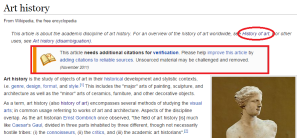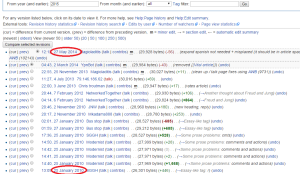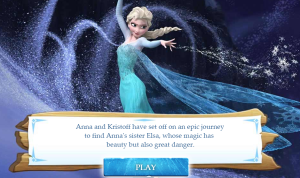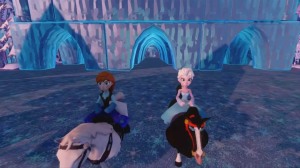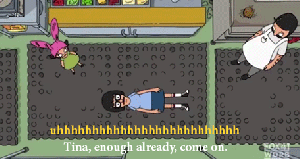The popular site, Wikipedia, is composed of a variety of topics and is constructed by collective intelligence. As defined by Henry Jenkins, this is the “ability to pool knowledge and compare notes with others towards a common goal.” This knowledge is constructed through networking by being able to pull information through the different sources of individuals.
For this assignment, I researched one of my favorite subjects – Art History. While I could have explored any specific movement, I believe the general subject page was the most interesting to read over. While the introduction of the subject as a whole was very accurate, you really can’t learn about the subject through the page. You get directed to a completely different page (History of Art) but this page also left out a lot of important movements in art history and it did not mention many famous individuals (such as the general art history page also did not) which I consider very important in the make-up of art history. To anyone who was learning about art history for the first time through Wikipedia, they would not be able to gain very much knowledge of the subject. Art History is composed of a variety of movements, individuals, and artistic works in many mediums and techniques. I believe this page could be heavily expanded by, at least, adding a timeline linking each specific art period to it’s wiki page. It was also lacking in images of artworks, which is a big part in learning of the subject.
The subject is very vast, I wondered if that was the reason it was not compromised of so orderly. I viewed the talk page next to see what many editors had brought up with the concern of this page, and I was proven to be not the only person to address the oddity of this “collective intelligence.” There seemed to be not much negotiation between how the art history page should be constructed when it came to the history of art in detail.
Now venturing into the view history page, it was not surprising to see the lack of edits over time. There were very few edits done per year, and it made me conclude that perhaps this Wiki page was so poor overall because not many Wikipedians are knowledgeable in the history of this subject. Perhaps if this was the page of a movie or a game (anything relatively popular in this modern day) the page would be much more updated. Also considering it is an educational subject, there is probably many other websites with more credible information.
The community around the art history page is severely lacking in information. If the subject had more people who have a better understanding of it adding their knowledge to this page, it could be a lot stronger, and the increased collective intelligence would give a better overview of the subject. Overall, the page does not do a bad job to a person who just wants a brief description of what the subject is, but it mainly discusses how we reached art history as a subject and not necessarily the incredible history of art as many would expect to gain by viewing the art history Wiki page.
Sources:
Jenkins, Henry. “What Wikipedia Can Teach Us About The New Media Literacies (Part One & Two).” Confessions of an Aca-Fan. Wordpress. 26-27 June 2007. Web. 6 March 2015.
